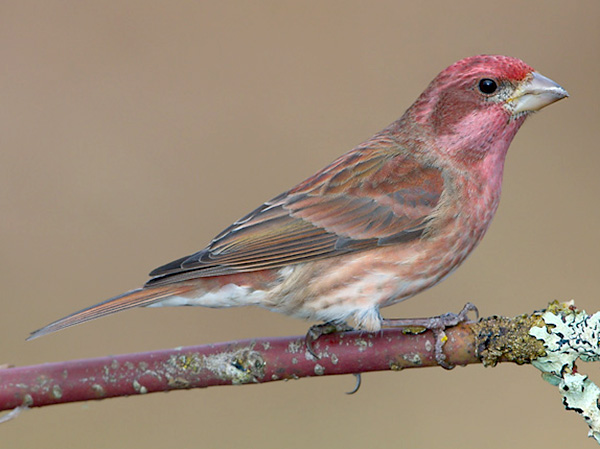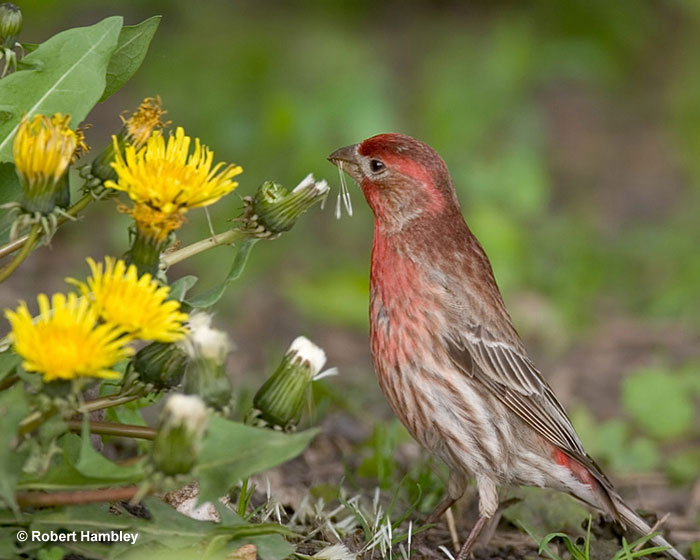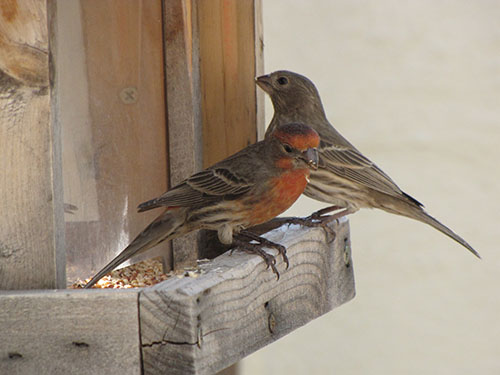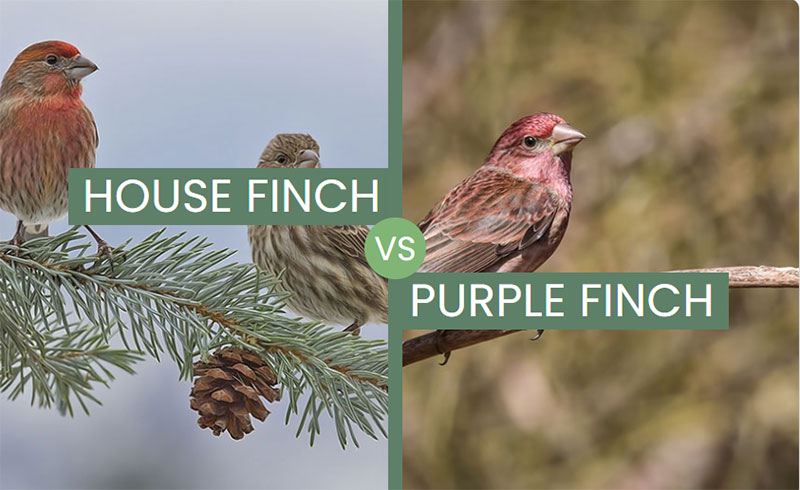House Finch vs Purple Finch – they look uncannily similar. This pair of closely related species can be a challenge to identify! However, we can identify them by paying close attention to certain field marks and vocalizations.
The main differences between House Finches and Purple Finches are the amount of red on the bird, and the pattern on the face.
Their songs are similar but the Purple Finch sings a more melodious and “warbling” song. The House Finch incorporates more chattering and trilled sounds.
On this page
Body & Shape
Both species are plump, sparrow-sized birds with strong, conical bills suited for eating seeds.
Being closely related, they have very similar body shapes, but the bill of the Purple Finch is a little bit bigger, more conical, and deeper, while that of the House Finch has a more rounded shape.

Pair of House Finches
The body of the Purple Finch also looks a little bit heavier or more rotund than the House Finch. Each species has a short to medium-length, forked tail, and medium length legs with fairly strong feet suited for grasping branches and hopping on the ground.
Both species also have rather long wings to help them fly long distances between food sources but, as with most migrant species, those of the Purple Finch have longer primary feathers.
While singing or in agitated situations, each can also show a hint of crest.
Related: Identification of Red Finches
In flight, the House Finch looks daintier than the Purple Finch and looks like it has a smaller, more rounded head, and slightly longer tail.

This is a Purple Finch. Photograph © Glenn Bartley.
House Finch vs Purple Finch Size
The Purple Finch and the House Finch are around the same size as a sparrow. Although they aren’t in the same family as sparrows, they are shaped a lot like those seed-eating birds.
The average size of both species is six inches in length but the Purple Finch weighs a bit more. It also has slightly longer wings than the House Finch.
The average weight of the Purple Finch is 25 grams, while House Finches weigh 20 grams. Their respective wingspans are 10 inches and 9.5 inches.
Speed
Both the Purple Finch and the House Finch have an undulating flight pattern. This makes them look like they are bounding up and down as they fly.
The exact flight speeds of these two species have never been measured but are probably similar to flight speeds of other small birds that live in similar, open and semi-open habitats.
They probably fly 30 mph on average but, when chased by a predator, may briefly fly as fast as 40 mph or more.
Although flight speed of the Purple Finch has never been compared to that of the House Finch, it does have longer wings. Since the Purple Finch uses those long wings to fly from boreal forests in Canada all the way to the southern USA, it can probably fly faster than the House Finch. It probably also flies for longer periods of time than House Finches.
Age
The Purple Finch and the House Finch probably have similar lifespans. There isn’t much information about the lifespans of these and most other small birds but based on recapturing of banded birds, the oldest House Finch was 12 years old, and the oldest Purple Finch was 14.
Since these numbers come from very limited data, both species could potentially live a bit longer, especially in captivity. However, most individuals of both species probably live for fewer years.
One study of marked House Finches showed that a large number of adult birds were five years old, and a fair number were six years of age. Such lifespans are typical for a lot of small bird species, and, as with many other small birds, both Purple Finches and House Finches begin to breed as soon as they become adults (at one year of age).
Breeding at an early age and having fairly large clutches probably helps offset the rather short lifespans of these finches, and other small birds with similar habits.
House Finch vs Purple Finch Behavior
The House Finch is a very social bird that forms pairs when breeding but flocks together at other times of the year. They can occur in a variety of open and semi-open habitats as well as urban areas.
Although these finches may argue with each other over breeding territories and food, for the most part, House Finches get along with each other.

They also get along fairly well with other small birds at other times of the year. House Finches often flock with goldfinches, House Sparrows, and other species. A variety of predators eat them including snakes, domestic cats, ground squirrels, owls, Merlins, Cooper’s Hawks, and Sharp-shinned Hawks.
When a group of House finches finds a predator, they usually mob or harass the animal from a safe distance. They can do this to owls and hawks but, in desert habitats, are especially concerned with snakes, including the Western Diamondback Rattlesnake.
The Purple Finch acts in a similar fashion but is more a bird of forested habitats and doesn’t form flocks as large as the House Finch. It can also harass potential predators and is preyed on by various animals including squirrels, Blue Jays, Merlins, Sharp-shinned and Coopers Hawks, domestic cats, and other species.
House Finch vs Purple Finch Diet
The House Finch and Purple Finch have diets that consist of seeds, nectar, fruits, and some insects.
Although they do overlap in some of the things they eat, in general, the House Finch eats more seeds of weedy plants in open areas such as thistle, mustard, and knotweed, while the Purple Finch feeds more on the seeds of trees like elms, juniper, and Mountain Ash among many other trees.
Both birds also commonly eat seeds at feeders, and the Purple Finch seems to show a preference for thinner and longer seeds instead of rounded ones.
Both species also enjoy nectar but unlike hummingbirds that sip nectar from the flower, the Purple Finch crushes the base of flowers to get at the nectar inside. It can forage on the ground but usually feeds on seeds, fruit, and buds on the outer edges of branches in trees, sometimes, high above the ground.
The House Finch can forage in a number of ways but often takes food from the ground and while perched in low vegetation. It may also eat fruit more often than the Purple Finch, feasting on papaya in Hawaii, and eating cherries and other fruits in other parts of its range.
Location
The House Finch is native to a wide range of arid, open, and semi-open habitats. It is native to the western USA from southern British Columbia south to southern Mexico, and east to areas just east of the Rocky Mountains. This adaptable bird avoids dense forest but will live in oak-juniper woodlands, open coniferous forest, deserts, and shrubby habitats from sea level to more than 11,000 feet.
Ever since a small flock in Long Island, NY, escaped from captivity in 1939, this species of western regions has also become a common bird in the eastern USA and southern Canada.
Over the years, that population has grown and expanded to millions of birds that thrive in urban and suburban places. These eastern House Finches prefer parks and urban situations with conifers and ornamental trees but can also live in farmlands.

This species also lives in Hawaii where it has become a common bird of garden and edge habitats.
During the breeding season, the Purple Finch doesn’t usually occur with the House Finch. It prefers much more forested habitats such as coniferous and mixed forests in the boreal zone.
It can also live in orchards, riparian zones, and parklands with conifers and ornamental trees. This pretty finch breeds in coniferous forests from the Yukon east to Newfoundland, the Great Lakes Region, the northeastern USA, in the Appalachians, and in the Pacific Northwest to southern California.
In the winter, it can occur with the House Finch in wooded and edge habitats on the Pacific coast, in southern Arizona, and in much of southern Canada and the eastern USA.
Nest & Eggs
The female House Finch builds a soft, cup-shaped nest made of twigs, rootlets, and other materials. The nest is placed in a spruce or other conifer, cactus, cliff, building ledge, or other spots with a solid base and some overhanging material.
The nest is usually 12 feet high, and she lays two to seven, pale blue eggs with purple speckling. They weigh 3 grams each and are incubated for two weeks. The nest is 3.9 inches in diameter and the inside cup has a depth of nearly an inch.
The female Purple Finch constructs a similar sized, cup-shaped nest made of twigs and rootlets, The nest is lined with grass, animal hair, and fiber, and can be on the ground or placed on a branch up to 50 feet high.
It is usually built underneath an overhanging branch in a conifer. The eggs are nearly an inch long, weigh 4.2 grams, and are pale green-blue with some dark red speckling. The female incubates them for nearly two weeks.
House Finch vs Purple Finch – Frequently Asked Questions
What is the difference between a House Finch and a Purple Finch?
The male House Finch doesn’t have as much red on the neck and back as the Purple Finch. It also has a more rounded bill. The House Finch also has more orange-red plumage than the raspberry red of the Purple Finch.
How rare is a Purple Finch?
The Purple Finch is not rare, but compared to the House Finch, it is much less of an urban bird. The Purple Finch is common in coniferous forests and visits feeders, especially during the winter.
What’s the difference between a female House Finch and a female Purple Finch?
The female House Finch has a plainer face than the boldly streaked face of the female Purple Finch.
Do Purple Finches and House Finches flock together?
Purple Finches and House Finches do flock together, but not often. In some parts of their range, during the winter, Purple Finches and House Finches can occur together. This usually happens at feeders or in other feeding situations.


